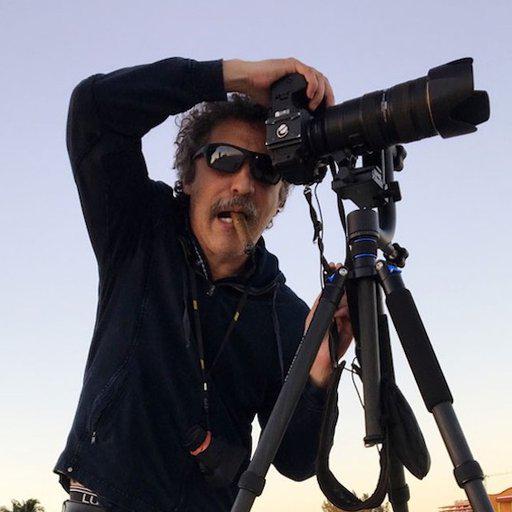Since the mid-eighties, Serge Hamad has created documentary work that focuses on war crimes and human rights issues. Incorporating both video and photography, Hamad’s wide range of work captures and informs sociopolitical situations in regions such as the Middle East and the Balkans. He feels that "an artwork is successful when it is injected into the communication channels and manages to awake a dialogue"
Hamad’s more abstract photographic series, such as Temporal Perception combine images of landscapes and digital rendering of soft hues and color gradients. Based in New York, Serge Hamad is a French-Algerian artist whose work has been exhibited in galleries throughout the US and abroad. His work has also appeared in auctions including Paddle 8, Artsy, Christie’s London, Sotheby’s and the Water Mill Foundation.
Works Available for Purchase

Interview with the Artist
1. When and why did you decide to become a photographer?
When I was four years old I used to catch butterflies armed with a net in our garden. One day I didn't just release the specimen I caught from the net as my father (a ranger) taught me to do. I picked the butterfly out of the net and remember running inside of the house to the dining room and placing it on our buffet to admire it closely. It couldn't fly, and crawled in such an awkward manner as if it was injured. Its wings had lost of their beautiful color, and my fingers where full of pigments. I panicked and knew that I harmed the butterfly. I started to cry, which made our dog bark and howl. The result was waking up my dad from his nap.
I remember my dad understanding my dilemma, although I didn't say a single word. "You shouldn't have touched its wings," he said. "All I wanted was to look at the butterfly closer because it was so beautiful," I replied. My dad's answer was: "If you want to see them from close then take a picture." He then gave me an old Kodak bellow camera, and I took a gazillion pictures the entire summer not knowing that a camera needed film.
As we moved from our villa located in a forest to the center of the city, the camera was lost and so were my butterflies. Six years later, I received an instamatic camera for my birthday and since then, I click like a happy child again.
2. You are walking down the street and realize you're about to walk in front of someone taking a picture and interrupt their photograph. Do you keep walking or stop and wait for them to take the shot?
I am a New Yorker, so I keep walking! Just kidding… I generally wait for them if I notice the situation.
3. What is your process when you shoot? Do you have any rituals?
I think I do what every pro photographer would do, check my gear and get in the frame of mind. The last one differs depending on what kind of photography I am doing. In war zones for instance, I used to totally clear my mind and rely on my instinct to tell a story in one click. For portraits, fashion…being social is the most important to me as you have to lead and motivate sometimes an entire team to get the best result.
4. You shoot in both color and black and white. How do you decide which to use for a project?
When I want to scream a message, I try to create a minimalist visual impression not to distract the viewer. And that's when I chose black and white. I don't believe in rules like that street photography for instance has to be in black & white only. X-Rays, maybe?
5. You are a human rights activist, as well as an artist. Do you think artists have a social responsibility?
I happen to be both, but I don't really think that an artist has to have a social responsibility as such.
To me, every citizen should have a certain amount of social responsibility and civil courage. On the other hand, art can be a powerful "weapon." Unfortunately for the good as well as the bad. Think of what "art" was used for in the Third Reich and, the total opposite, how Víctor Jara has used his talent in Chile. Nope! I am not a communist!
6. Last year you started the "Take a Stand" project, which protests human rights violations in Iran. What was your motivation for this project?
I took a stand against human rights atrocities at a young age when I decided to cover war zones. The Iran dilemma became part of my everyday life since I met my Iranian wife (23 years ago).
Last year my wife edited a documentary concerning an Iranian citizen who was condemned to death by stoning. That's when we decided to start the Take a Stand art project.
My goal is to inform people of the social and political situation in Iran, as well as how some human rights organizations like International Campaign for Human Rights in Iran and Omid Advocates for Human Rights are helping and even saving the lives of many Iranian people. I don't have a political agenda as I think that we need a peaceful dialog to make a change rather then a call for useless sanctions and phobia.
My main artwork and message is called "OMID," which means "Hope" in Farsi. Click here to find an example of it with Mr. Robert Wilson. During the exhibitions, I take the same portrait of the guests who are willing to send this message.
7. What's in your camera bag?
For stealth photography:
- Old Olympus OM2 & OM3 with a 35mm, 21mm, 55mm f 1.2
- Leica M7 with 35mm f1.4, 90mm f2.0
For landscapes and people:
- Nikon D3X & D3S with Zeiss 85mm f1.4, 17-35mm f2.8, 70-200 VR II f2.8
- Mamya 7 II with 65mm f4, 150mm f4.5






